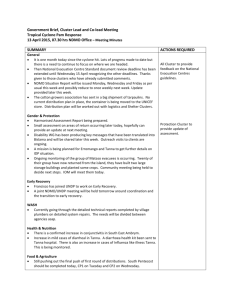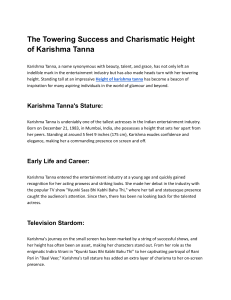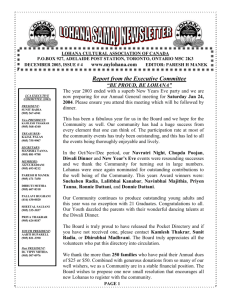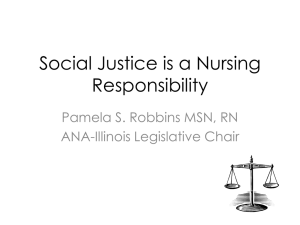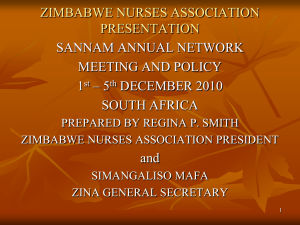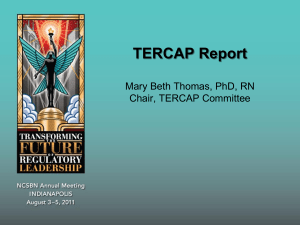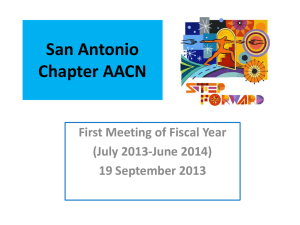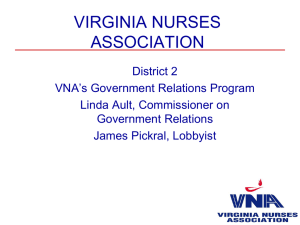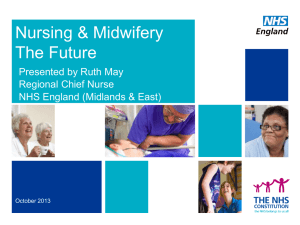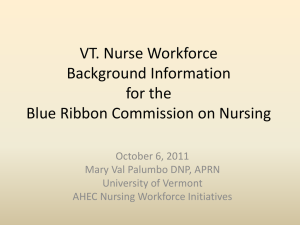TANZANIA NATIONAL NURSES ASSOCIATION (TANNA)
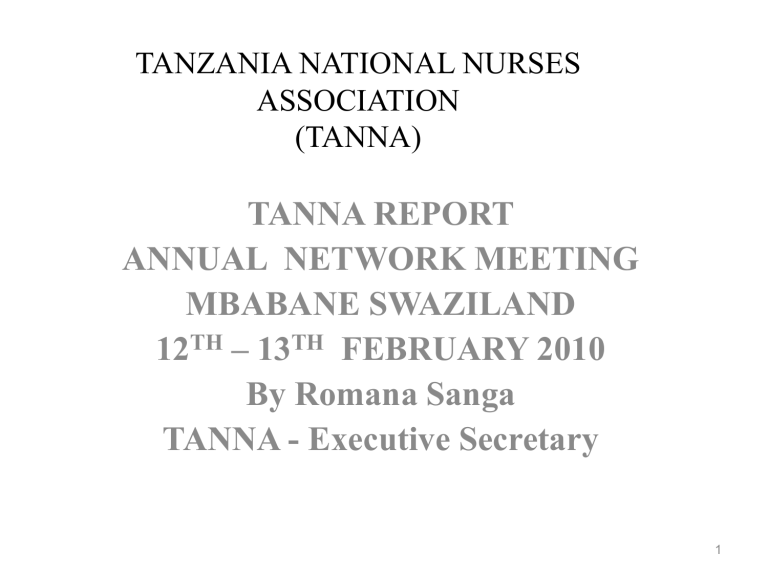
TANZANIA NATIONAL NURSES
ASSOCIATION
(TANNA)
TANNA REPORT
ANNUAL NETWORK MEETING
MBABANE SWAZILAND
12 TH – 13 TH FEBRUARY 2010
By Romana Sanga
TANNA - Executive Secretary
1
Introduction
Background
• Tanzania is a United Republic of two countries –
Tanzania Mainland and Zanzibar
• There are union matters and non-union matters; health is not a union matter hence our association is for the Tanzania Mainland only.
• N urses association was established in Tanzania on
29 th November 1971 which was known as
Tanzania Registered Nurses Association
(TARENA)
2
Introduction
cont’d
•
In 2005 the constitution was reviewed and our association changed to Tanzania National
Nurses Association (TANNA) and this has enabled the involvement of not just registered nurses but also all enrolled nurses throughout the country
3
Introduction
•
Currently TANNA has a total of 8,500 members out of 22,000 Enrolled and
Registered nurses
•
The Association has a total of 29 Regional
Branches
•
TANNA operates and is guided by its constitution which was adopted after it was established in 2005.
4
Political and Social Events
Annual General Meeting in April 2009
Various nursing stakeholders supported this meeting financially. These were individuals and organizations from both private and public sectors.
Enabled nurse’s, both members and non members, to participate and share the views on the nursing profession and challenges they face in providing services to the community.
5
Political and Social Events
International Nurses Day
The International Nurses Day was commemorated successfully nationally in Dar
Es Salaam and in all Regional branches and hospitals across the country
TANNA invited the Prime Minister,
Honorable Peter Kayanza Mizengo Pinda,
(MP) as Guest of Honor for the occasion.
6
Political and Social Events
International Nurses Day cont’d
In his speech he urged nurses to abide to the nursing ethics and promised to support nurses.
In cerebrating the Nurses Day, TANNA held a four day exhibition which involved nurses from Dar es Salaam showing nurse activities and services to the clients.
The exhibitions gave TANNA the opportunity to be better known by the public at large.
7
LEADERS FORUM
TANNA held its leaders forum on 10 th -12 th
December 2009
Three representatives from
28 Regional TANNA
Branches attended the meeting. These were the chairpersons, secretaries and treasurers
The forum aimed to explore the challenges facing
TANNA and nursing profession
8
Country’s Economy and its Impact to Health
Positive impact:
•
Improving infrastructure for easy access to health facilities etc
•
Construction of health facilities for each village to serve the public
•
Ensuring availability of drugs in all health facilities
•
Implementing policies that emphasized on reducing mortality rates especially Maternal and
Child Mortality Rates
9
Country’s economy and its impact to health
•
Implementing policies that put emphasis on the fight against malaria, ITN especially for hospitalized mothers and infants
•
Provision of Ambulances for many District hospitals
•
Provision of mobile free services for testing
HIV/AIDS
•
Provision of free ARV for victims of HIV/AIDS
•
Increasing enrollment of more nurse students in order to tackle acute shortage of nurses in the country.
10
Country’s Economy and its Impact to
Health
Negative impact
•
Health facilities experience acute shortages of human resources
•
Power shortage has had serious impact on the provision of services in all health facilities.
•
Due to shortage of funds some health facilities are non operational
11
Challenges to Nursing
65% Shortages health professionals at facility level which is more severe in rural areas.
Demand of quality health services against the limited resources
Professional nurses mobilization from within the country and outside the country
Epidemiological change of diseases contribute to challenges for nursing services, for example HIV /AIDS pandemic, T.B, malaria and others.
12
Challenges to Nursing
Negative public image towards services provided by nurses
Low pay of nurses compared to other professions
Insufficient lobbying skills
Insufficient working tools
13
TANNA Activities
Implemented TANNA needs assessment, to get views from TANNA how to strengthen
TANNA
The outcome of the assessment made it possible to design a work plan which will enable the establishment of those activities.
Mobile libraries that funded by ICN and operated in the refugee camps were placed under the government-owned schools of nursing
14
Future planned activities for
TANNA
Training on lobbying skills
Implement a positive working environment campaigns.
Continuing education at working place
Screening programmes for diabetics etc
Promote practice in research standards
15
Mission and Vision of our
Association
Vision
A national leading and reputable
Nursing/Midwifery professional group for excellence in Nursing education, research,
Nursing/midwifery practice and other health service delivery (TANNA Strategic Plan,
2006)
16
Mission and vision of your association
Mission
The Association is dedicated to promote competencies among the Nurses and Midwives for quality provision of nursing, midwifery and other health services nationally and internationally using its well- equipped and highly motivated regional branches.
Taking a wide look around at what’s going on outside the Association and how it might affect the professional Association
17
Categories of Nurses in Tanzania
There are 8,850 Registered Nurses i.e. nurses with educational level of diploma and degrees
There are 14,454 Enrolled Nurses. These are nurses with certificate level of education
All are legible to be members of the association
18
TANNA Branches and TANNA members
TANNA Branches
There are 29 branches in all regions and national and referral hospitals.
TANNA members
TANNA has a total of 8,500 but only about
3,500 members are active.
19
International Affiliations
•
ICN in collaboration with UHCR and MERK has been working with the project of Mobile
Library which introduced 37 libraries in phases
•
SANNAMcollaborates with SANNAM in
Research proposals of HIV and AIDS in
Tanzania, holding meetings and sharing health related issues and challenges.
20
International Affiliations
ECSACON in meeting presentations of issues in nursing particularly HIV and AIDS.
Norwegian Nurses Organisation (NNA)
Supported TANNA in 1995 purchasing an office vehicle and office building, but currently those properties are worn out.
CNF – In 2009 Successfully conducted a workshop in Dar-Es-Salaam on infection control.
21
National and International
Affiliations
Ministry of Health and Social Welfare -
Recognizes the Association and has supported it in paying the annual fees for its membership in International organizations i.e. ICN,
ECSACON and SANNAM
22
Experiences on SANNAM
•
The majority of TANNA members are not aware of SANNAM.
•
However current leaders have been active in the activities of SANNAM and have continuously been sensitizing them to TANNA members in various meetings.
23
TANNA legal standing:
Strategic plan and constitution
•
TANNA members are all licensed by the
Tanzania Nurses and Midwives Council which is statutory organization regulating the nursing and midwifery professions
•
TANNA is registered by the Registrar of
Associations.
24
Source of in come
Membership fees and subscription
Fund raising programs
Donation, gift and grants
Subsidies from the Government
Loan from any financial institution
Sale of Association assets
Any other sources as authorized by the
TANNA leadership
25
The Major Challenges in the
Sustainability of our Association
Poor communication due to inadequate funds
Lack of full time administrative staff to all levels of TANNA leadership structure.
26
Challenges in the Sustainability of
Association
Negative public image towards nurses
Low number of TANNA members
Insufficiency training and lobbying skills to
TANNA leaders
Insufficiency funds to promote quality nursing services to improve positive image to the public
Insufficient incentives to retain/attract nurses in their working places particularly in rural areas
27
Way forward
Sensitize more nurses to join TANNA
Improve communication
Employ permanent staff to the National
TANNA headquarters
In service Training
Find ways to improve income generating activities for nurses
Considering making the association a union
28
= end =
29
